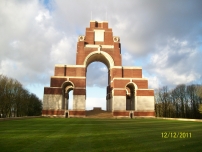| First Name: | John | Last Name: | HARRIS | |
|---|---|---|---|---|
| Date of Death: | 01/07/1916 | Lived/Born In: | Queen's Park | |
| Rank: | Lance Corporal | Unit: | Middlesex2 | |
| Memorial Site: | Thiepval Memorial, France | |||
Current Information:Age-27 75, Third Avenue, Queen's Park
The opening day of the Battle of the Somme 1st July 1916 This was a disastrous day for the British Army in France. Eleven divisions of Fourth Army attacked along a 15 mile front from Maricourt to Serre. Two further divisions of Third Army launched a diversionary attack just to the north of Serre at Gommecourt. For a week beforehand the British artillery pounded the German trenches but the Germans had been there for a long time and they had constructed deep, concrete reinforced shelters beneath their trenches and many survived the bombardment. The troops went over the top at 7.30 am but even before they had left their overcrowded trenches, many had been killed or maimed by German artillery. The Germans knew that they were coming. Once in No-Man’s-Land the artillery continued to take its toll and then the machine guns opened up on the advancing British infantry. They fell in their thousands and the attack came to a standstill almost everywhere. Survivors sought cover wherever they could find it and at night they crawled back to their own lines, often dragging a wounded soldier with them. Only in the south were any advances made with the attack on Fricourt and Mametz. Over 19,000 British soldiers were killed on this day, including 2,500 from London. On 1st July, 1916, 8th Division attacked the Ovillers spur with 23 Brigade on the right, attacking along the exposed slopes of Mash Valley. For the last eight minutes before zero Stokes mortars pounded the German line and the leading troops moved out some 200-300 yards into no-man’s land. Despite this concentrated British barrage, at least two German machine guns kept firing from their front line. At 7.30 am, the leading battalions advanced in four lines, each fifty paces apart. German fire grew from Ovillers, La Boiselle and their 2nd trench and when the advancing troops got to within eighty yards of the German line it became extremely violent. At the same time a German barrage of no-man’s land and on the British front and support trenches caused many more casualties. Inevitably the wave formation soon ceased to exist as the men tried rushing the German lines across ground that was uncratered and provided no cover. 2nd Middlesex and 2nd Devonshire were the assaulting battalions of 23 Brigade with 2nd West Yorkshire in support and 2nd Scottish Rifles in reserve. The attack at 7.30 am was immediately met by a storm of machine gun and rifle fire sweeping away the first three waves. Only 200 reached the German line where they dealt ruthlessly with the Germans before moving on to their 2nd line and more hand to hand fighting. Another 100 casualties here forced the survivors back to the German front line By 9.15 am their numbers had dwindled to around twelve unwounded men and they were forced to retire to shell holes in no-man’s land where they remained all day until able to crawl back after dark. 2nd Devonshire suffered a similar fate. Only one officer of the twenty three of 2nd Middlesex who had taken part in the attack returned unwounded and only fifty men answered their names at roll call that night. One of those killed on this day was John Harris. |
||||
| « Back to Search Results | ||||
| If you think any of the information shown here is incorrect, Click Here to submit your amends and comments | ||||




